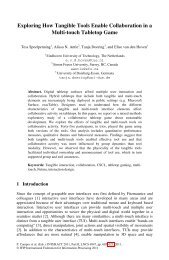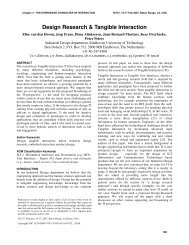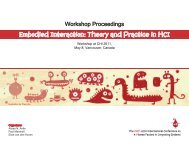Sissy - Elise van den Hoven
Sissy - Elise van den Hoven
Sissy - Elise van den Hoven
Create successful ePaper yourself
Turn your PDF publications into a flip-book with our unique Google optimized e-Paper software.
The notion that physical movement is a material for<br />
design challenges interaction designers to become more<br />
attuned to their physicality. To date in our work this has<br />
extended only to participating in group warm-ups during<br />
workshops, and so there is considerable scope to take this<br />
further.<br />
While we are receptive to the idea that becoming more<br />
attuned to their physicality will enhance interaction<br />
designers’ connection with the dancers’ craft and lead to<br />
better interactive systems, we are also mindful of the gap<br />
between the amateur and professional, in terms of ability<br />
certainly, but perhaps more importantly in the level of<br />
sophistication of domain knowledge. Composers are<br />
sometimes warned that trying to learn the instruments<br />
they compose for is counterproductive, as the level of<br />
understanding they can develop in short term ‘dabbling’<br />
with the instrument is several orders of magnitude less<br />
sophisticated than that of the professional musician. We<br />
don’t doubt that becoming sensitised to the physicality of<br />
the performers’ craft is worthwhile, but there is a risk that<br />
it can lead us to constrain the scope of design possibilities<br />
when working with high-level performers.<br />
CONCLUSIONS<br />
In this paper we have presented an overview of work with<br />
musicians and dancers in which physical modelling<br />
techniques are used to attempt to create intuitively<br />
controllable audio-visual systems that facilitate<br />
conversational interactions. As our work on Encoded<br />
progresses we are mindful of the need for those involved<br />
in the interaction design for the project to become more<br />
attuned to their physicality. We feel that we have much<br />
to learn about how professional movers think about (and<br />
through) their bodies.<br />
We hope this paper provides readers with some of the<br />
ideas and strategies we are applying in our creative work<br />
and research and will stimulate discussion of the<br />
relationships between physicality, embodiment and<br />
systems for creative expression.<br />
ACKNOWLEDGMENTS<br />
Encoded is supported by grants from the Australia<br />
Council for the Arts, Creative New Zealand, Arts New<br />
South Wales, Q Theatre Penrith and CarriageWorks.<br />
REFERENCES<br />
Fels, S. (2004), 'Designing for intimacy: creating new<br />
interfaces for musical expression', Proceedings of the<br />
IEEE 92(4), 672-685.<br />
Johnston, A. (2009), 'Interfaces for Musical Expression<br />
Based on Simulated Physical Models', PhD thesis,<br />
University of Technology Sydney.<br />
Johnston, A.; Candy, L. & Edmonds, E. (2008),<br />
'Designing and evaluating virtual musical instruments:<br />
facilitating conversational user interaction', Design<br />
Studies 29(6), 556--571.<br />
Larssen, A. T.; Robertson, T. & Edwards, J. (2007),<br />
Experiential Bodily Knowing as a Design (Sens)-ability<br />
in Interaction Design, in L Feijs; S Kyffin & B Young,<br />
16<br />
ed.,'Proceedings of Design & Semantics of Form &<br />
Movement', pp. 117-126.<br />
Leman, M. (2007), Embodied Music Cognition and<br />
Mediation Technology, The MIT Press.<br />
Levin, G. (2000), 'Painterly Interfaces for Audiovisual<br />
Performance', Master's thesis, Massachusetts Institute<br />
of Technology.<br />
Smith, J. O. (2004), 'Virtual acoustic musical instruments:<br />
review and update', Journal of New Music Research<br />
33(3), 283--304.



![Download 1.8 MB [pdf] - Elise van den Hoven](https://img.yumpu.com/18078175/1/190x245/download-18-mb-pdf-elise-van-den-hoven.jpg?quality=85)

![Download 0.2 MB [pdf] - Elise van den Hoven](https://img.yumpu.com/18078145/1/182x260/download-02-mb-pdf-elise-van-den-hoven.jpg?quality=85)
![Download 0.1 MB [pdf] - Elise van den Hoven](https://img.yumpu.com/18078125/1/190x146/download-01-mb-pdf-elise-van-den-hoven.jpg?quality=85)
![Download 1.9 MB [pdf] - Elise van den Hoven](https://img.yumpu.com/18078041/1/182x260/download-19-mb-pdf-elise-van-den-hoven.jpg?quality=85)

